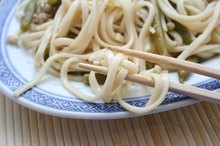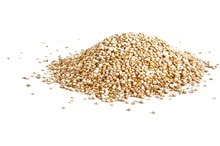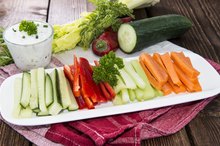Lentil Serving Size
Lentils fall into the beans and peas group, which means they can be counted toward either your recommended vegetable consumption or your recommended protein consumption for the day. The U.S. Department of Agriculture recommends everyone age 14 and older eat at least 1 1/2 cups of beans, peas or lentils per week as part of a healthy diet.
A Serving of Lentils
A serving of cooked vegetables or starchy carbohydrates, such as lentils, is typically half a cup. This serving contains 115 calories and would count as half of a cup of vegetables toward the 2 1/2 to 3 cups recommended per day for adults. It is also equivalent to 2 ounces of protein, toward the recommended 5 to 6 1/2 ounces per day. The USDA recommends counting lentils as a protein food if you haven't met your minimum recommended protein intake for the day and as a vegetable if you have already consumed enough protein.
- A serving of cooked vegetables or starchy carbohydrates, such as lentils, is typically half a cup.
- It is also equivalent to 2 ounces of protein, toward the recommended 5 to 6 1/2 ounces per day.
Related Articles
References
- North Dakota State University: Pulses: The Perfect Food
- MedlinePlus: Carbohydrates
- Lentils, dry, cooked, fat not added in cooking. USDA FoodData Central. Updated April 1, 2019.
- Abeysekara S, Chilibeck PD, Vatanparast H, Zello GA. A pulse-based diet is effective for reducing total and LDL-cholesterol in older adults. Br J Nutr. 2012;108 Suppl 1:S103-10. doi:10.1017/s0007114512000748
- Ganesan K, Xu B. Polyphenol-Rich Lentils and Their Health Promoting Effects. Int J Mol Sci. 2017;18(11):2390. Published 2017 Nov 10. doi:10.3390/ijms18112390
- Polak R, Phillips EM, Campbell A. Legumes: Health Benefits and Culinary Approaches to Increase Intake. Clin Diabetes. 2015;33(4):198–205. doi:10.2337/diaclin.33.4.198
- Ha V, Sievenpiper J, de Souza R et al. Effect of dietary pulse intake on established therapeutic lipid targets for cardiovascular risk reduction: a systematic review and meta-analysis of randomized controlled trials. Can Med Assoc J. 2014;186(8):E252-E262. doi:10.1503/cmaj.131727
- Sievenpiper JL, Kendall CW, Esfahani A, et al. Effect of non-oil-seed pulses on glycaemic control: a systematic review and meta-analysis of randomised controlled experimental trials in people with and without diabetes. Diabetologia. 2009;52(8):1479-95. doi:10.1007/s00125-009-1395-7
- Rebello CJ, Greenway FL, Finley JW. A review of the nutritional value of legumes and their effects on obesity and its related co-morbidities. Obes Rev. 2014;15(5):392-407. doi:10.1111/obr.12144
- Variety of lentil proteins makes recommendations on avoidance difficult. American Academy of Allergy, Asthma, and Immunology. Published July 24, 2015.
- Legumes (Including Pulses). Anaphylaxis Campaign. Published March 2019.
- Jensen K, Ni Y, Panagiotou G, Kouskoumvekaki I. Developing a molecular roadmap of drug-food interactions. PLoS Comput Biol. 2015;11(2):e1004048. Published 2015 Feb 10. doi:10.1371/journal.pcbi.1004048
- Ndidi US, Ndidi CU, Olagunju A, Muhammad A, Billy FG, Okpe O. Proximate, Antinutrients and Mineral Composition of Raw and Processed (Boiled and Roasted) Sphenostylis stenocarpa Seeds from Southern Kaduna, Northwest Nigeria. ISRN Nutr. 2014;2014:280837. Published 2014 Mar 16. doi:10.1155/2014/280837
- Anti-nutritional Factors. U.S. National Library of Medicine.
- Before You Toss Food, Wait. Check It Out! U.S. Department of Agriculture.
Writer Bio
Based in Massachusetts, Jessica Bruso has been writing since 2008. She holds a master of science degree in food policy and applied nutrition and a bachelor of arts degree in international relations, both from Tufts University.









